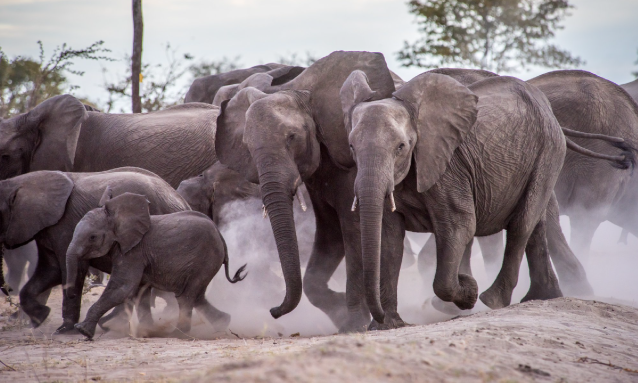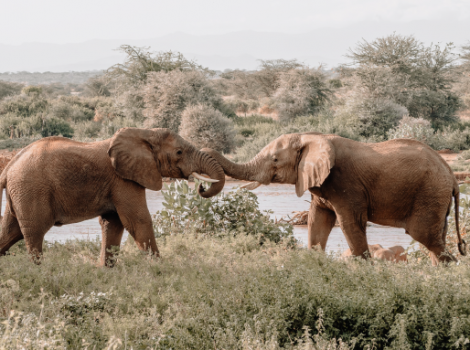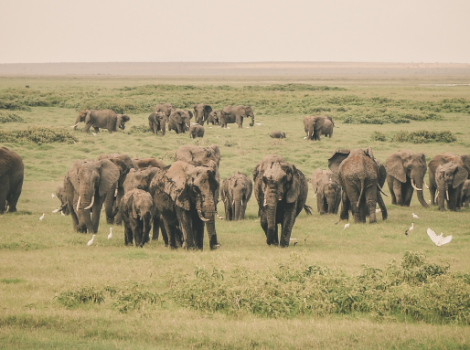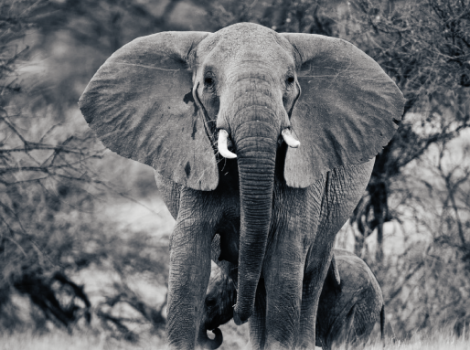
Today’s Wall Street Journal (June 19) carried an edifying op-ed penned by Mokgweetsi Masisi, the President of Botswana. That Southern African country of a little over two and a quarter million inhabitants is being overrun by elephants. In the mid-1990s, President Masisi reports that there were roughly 50,000 elephants in Botswana.
Since then, the elephant population has exploded to more than 130,000 -thanks, in part, to a ban on hunting. Now, Botswana’s elephants pose a danger to life, limb, and property. So, in May, the government indicated that it would lift the hunting ban. This drew outrage from many, but not from rural Batswana who have witnessed their property destroyed, neighbours killed and lives disrupted by elephants.
President Masisi argues that controlled big game hunting would transform the elephants from vermin into something of economic value. This, he concludes, would save the elephants. President Masisi is right. I know. I spent considerable time studying the problem of wildlife conservation in Africa many moons ago.
It all started with a lunch in 1972 and subsequent collaboration with Richard Leakey – son of the famous paleontologists Louis and Mary Leakey, a famous paleontologist in his own right, bon vivant, etc… In addition to paleontology, Leakey has a passion for wildlife conservation. I learned of this during my first lunch with Richard Leakey in the spring of 1972. It was then that the anthropologist Neville Dyson-Hudson, an expert on East African pastoral peoples, and I broke bread with Leakey at the Johns Hopkins Faculty Club in Baltimore. I anticipated plenty of paleontology and anthropology, but those weren’t on the menu. The conversation quickly turned to the topic that most interested Leakey, and as it turns out, the reason why my former colleague Dyson-Hudson had invited me to lunch in the first place: to discuss the economics of wildlife resources. Leakey had a vision of land use and wildlife resources in East Africa. His observation was that the East African savannahs were, in large part, common property resources. In addition, Leakey noted that the wildlife that roamed over these vast savannahs were fugitive common property resources, too.
He concluded that, unless property rights could be established, both the savannahs and wildlife would eventually be destroyed. For him, this would be a great tragedy, not only for wildlife, but also for indigenous peoples living off the lands in East Africa.
Leakey questioned whether the current system – burdened with its common property problems and regulated by a very British-type system of hunting rules (charges for hunting licenses and penalties for unlicensed hunting, violations of closed seasons and the killing of protected species) – was sustainable. He also questioned whether parks and game reservations – coupled with restrictions on the trade of wildlife meat, skins, and trophies – would actually conserve wildlife.
Leakey’s conjecture was that, if private property in the savannahs and wildlife resources could be established, they could be properly managed to enhance land-use productivity. This, he concluded, would give wildlife economic value, save it from destruction, and enhance the economic wellbeing of those indigenous peoples who co-exist among the wildlife herds.
Leakey wanted to know what I thought of his ideas. Could good property rights cut down on poaching and corruption, save wildlife , and enhance the productivity of East Africa’s savannahs? Could well-managed game cropping, trophy hunting, tourism, and so forth, coupled with pastoral herding, generate more prosperity than the current land-use arrangements? Could such a wildlife-oriented economy co-exist with traditional herding? And on-and-on the questions flowed.
My response was that I thought Leakey, in principle, was on the right track, but that definitive answers as to how one would establish property rights in East Africa’s common property resources, as well as the economic values involved, would require practical, empirical investigation. Field work and the collection of primary data, among other things, would be required. At that point, Leakey, director of the National Museums of Kenya, responded positively. He invited me to prepare a research proposal, and, subject to his approval, join him as a Research Associate.
I agreed and wrote a proposal, which he approved. In the summer of 1972, I arrived in Nairobi, where I took up residence at the Norfolk Hotel. In addition to spending hot days in Nairobi going over records of hunting licenses, ivory, and game trophy export permits, I spent about a month in the field on safari. I have many remembrances of that. Two notable ones come to mind. While camping in the Masai Mara National Reserve, I observed a great deal of poaching, some of it by government employees. Never mind. I also ran into Joy Adamson of Born Free fame out in the bush. It was in the middle of the afternoon when Adamson had her tracker and scout lay a fire, and we had tea. We spent an hour or so chatting about the economics of wildlife and conservation. She gave my research project a thumbs up, which was very encouraging.
What was not encouraging were some of the findings I turned up in the records back in Nairobi. When I added up the number of hunting licenses issued each year and export permits for ivory, etc., there was a huge gap. Legal exports of wildlife trophies, ivory, etc., which were recorded at the Customs Department, exceeded hunting licenses issued by the Game Department by a wide margin. There was trouble in paradise. Indeed, all my arithmetic pointed to a massive amount of corruption at the highest levels of government. When the Chief Game Warden figured out where my collection and analysis of what was considered rather obscure primary data were pointing, I became persona non grata. Shortly thereafter, I caught a flight from Nairobi to Switzerland, where the World Wildlife Fund (WWF) is located.
Upon arriving at the WWF headquarters in Morges, Switzerland, I started to put some of my notes together. Eventually, many of my findings appeared in a piece I co-authored with Robert K. Davis and Frank Mitchell, “Conventional and Unconventional Approaches to Wildlife Exploitation,” which was published in 1973. We concluded that the system of parks, protection, prohibitions on trade, and traditional hunting rules and regulations – no matter how well intended – were destined to fail at generating prosperity and conserving wildlife. Only by establishing secure property rights for land and wildlife would these resources be rendered valuable. Markets for them would then develop. In consequence, they would be wisely used, protected, and conserved. The prudent use of resources is, and always has been, all about property, prices, markets, and legitimate trade.
As President Masisi makes clear in his Wall Street Journal piece, my work on wildlife in the early 1970s is becoming more and more relevant with each passing day. On the one hand, conventional approaches to wildlife management in Africa have failed, as witnessed by the dramatic declines in wildlife populations – with Botswana being an exception. And on the other hand, the cost of establishing property rights in wildlife and reducing the problems associated with the commons have been dramatically reduced with the introduction of new technologies.
For example, satellites and drones hold the potential to establish property rights at ever-declining costs. These new technologies would protect the savannahs and the wildlife that roam on them. A comparable new technology to eliminate the commons was introduced during the 19th century in the United States. Barbed wire represented the new technology. To appreciate the cost plunge that accompanied the introduction of barbed wire, just consider that in 1874, a 100 pounds of barbed wire cost $20, and by 1897, this cost had plunged to $1.80, a 91% drop. At this reduced cost, barbed wire became widely used. And with that, private property was established and common property on the open range was eliminated. This allowed for conservation, wise land use, and enhanced animal husbandry.
For those who are truly interested in saving the elephants in Botswana and African wildlife in general, the establishment of property rights is of the utmost importance. Once resources are owned, they are protected and conserved.
Source: forbes.com
About the author:

Steve H. Hanke | Professor | Economist | Author | Currency Expert | White House Alum. Steve Hanke is a professor of applied economics at The Johns Hopkins University and senior fellow at the Cato Institute. Over four decades Hanke has advised dozens of world leaders from Ronald Reagan to Indonesia’s Suharto on currency reforms, infrastructure development, privatization, and how to tame hyperinflation. He also trades currencies and commodities and was the president of the world’s best performing mutual fund in 1995 ( 79.25%). He wrote a regular column in Forbes Magazine from 1993 to 2010. He and his wife reside in Baltimore and Paris. You can follow him on twitter @steve_hanke.



